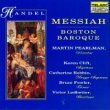CHORUS
His yoke is easy, his burthen is light.
Completing Part I, this fugal chorus is reworked from the first movement of Quel fior che all’alba ride on the text, “That flower which smiles at dawn the sun later causes to wither, and in the evening it goes to its grave.”10
This is a surprising movement, short on text and ironically long on technical demand for the singers. The word “easy” lies high and is set to a protracted melisma of intricate turns on 16th notes interrupted by a hiccough--an irregularity created by a dotted 16th- and 32nd-note combination. This “easy” yoke spans more than a measure in an easy-going tempo, while the “light” burden, frequently set on a lilting rising figure, comes in short bursts. The overall motion of the music is that of dance. At the beginning of the movement voices enter alone or in pairs, but close to the end of the movement the four parts work simultaneously. Even here, though, Handel does not let the music become massy. Instead of marching to the pulse laid down by the bass and continuo, he incorporates delightful syncopations in the chorus and upper strings, throwing the weight away from the expected points of accent and lightening the motion. [Excerpt 38] This wonderful movement reinforces the joyfulness of the Messiah’s good works.
From PART II
CHORUS
Hallelujah! For the Lord God Omnipotent reigneth. The kingdom of this world
is become the kingdom of our Lord and of His Christ; and He shall reign for ever and ever,
King of Kings, and Lord of Lords.
The impact of this most famous chorus comes in part from its expanded orchestra: besides the strings and continuo Handel included two oboes, two trumpets, and timpani. The context of this movement within the oratorio is important: it presents the final victory of God and his Messiah over those who have opposed and rejected his message toward the end of Part II. The trumpets and timpani are associated with triumphant royalty in Handel’s time. The key of D major is traditional for great victorious pieces because the Baroque high trumpet’s home key is D, so that even without the keys of the modern instrument it could contribute to a jubilee effect. Handel has given us a glimpse of God as a military king who has won over his opponents in a great war. The massive homophonic exclamations from the chorus suggest not just an adoring crowd but even a people acclaiming a newly crowned king. Similar expressions can be found in Handel’s Coronation Anthem “Zadok the Priest”, when the people cry out, “God save the king, long live the King!”
After the initial acclamations, Handel introduces a subject for constant imitation on the words “For the Lord God Omnipotent reigneth.” [Excerpt 39] As this theme expands through the choral voices, hallelujahs provide energy in the background. More and more activity brings the first section to a strong cadence. Then, a quieter section begins with a marvelous image. “The Kingdom of this world is become...” sits sedately in a moderately low range. But it is linked, by more than an octave leap up in sopranos, an octave leap up in the basses and big upward leaps in alto and tenor, with a musically parallel setting of “the Kingdom of our Lord and of His Christ.” The upward leap toward the heavenly realm is remembered with first notes of the bass presentation, “and He shall reign for ever....” [Excerpt 40] Naturally this is further presented in all voices, the tenors and sopranos particularly reaching quite to the highest point of their range. Trumpet-like acclamations of “King of Kings” are sustained “for ever and ever” and answered by repeated hallelujahs, and the first trumpet’s hair-raising descending scale propels the sopranos’ escalating series of high, brilliant statements, “King of Kings”, reinforced by the trumpet. [Excerpt 41] A period of more scattered fragments of the main themes feeds into a great homophonic conclusion of pulsating simultaneous statements “King of Kings...” and “for ever and ever...” Finally, in a drive to the last cadence, are repeated exclamations of “Hallelujah!” [Excerpt 42]
PAGE 1 2 3 4 5 6 7 8 9 10 11 12 13
10 Shaw, A textual companion to Handel’s “Messiah”, 168-169. |

